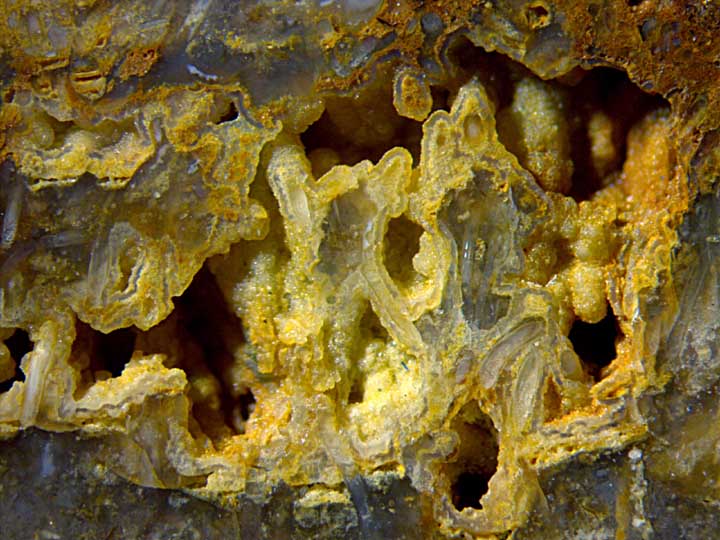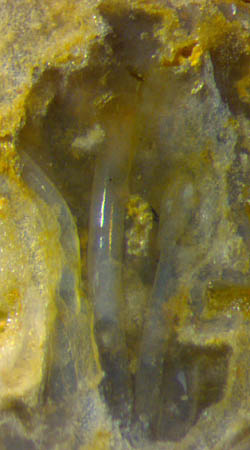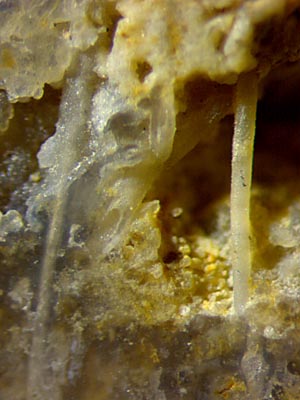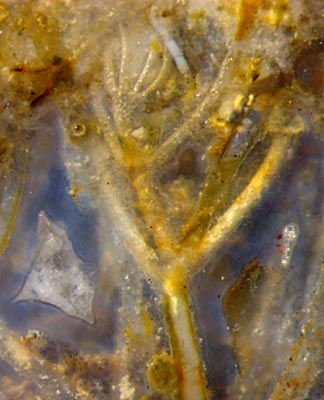Window into the distant past -
Palaeonitella
 This image may incite the imaginative onlooker to
see a fairy-tale
setting with caves and, if looked at attentively, a window into the
past, seen right of the middle in Fig.1 and enlarged in Fig.2.
This image may incite the imaginative onlooker to
see a fairy-tale
setting with caves and, if looked at attentively, a window into the
past, seen right of the middle in Fig.1 and enlarged in Fig.2.

Fig.1: Rhynie chert with cavities and the charophyte green alga Palaeonitella
preserved in chalzedony.
Width of the image 7mm.
Fig.2: Palaeonitella
parts
consisting of and embedded in clear chalzedony, providing the illusion
of looking through a window pane with glossy tubes behind.
Detail of Fig.1, width of the bigger tube 120Ám.
Behind the apparent glass front one can clearly see
transparent tubes which seem to have been formed with surprising
perfection. They have retained their transparency
and smoothness, and the space between the tubes has been kept clean for
400 million years, which had been facilitated by silicification of the
watery habitat of this alga. This must have gone on so quickly that
there was not much
time for decay processes except for the decay of the cell content.
An unexpected feature in the above images indicates that the
cylindrical surfaces of the plant parts are even smoother and cleaner
than immediately seen in
Fig.2. The specular reflection from the surface of the
cylinder distinctly seen through
the chalcedony, and the dimmer reflection from
the inner face of the hollow cylinder seen through
the chalcedony and the wall, justify the conclusion that any roughness
must be much smaller than the wavelength of the light, hence it seems
to be
well below 0.1Ám, as an estimate. Note that a statement of such
precision referring to a fossil is usually not obtained with a light
microscope. Also unusual is the life-like preservation. Live
Nitella
in water would not provide a better picture than Palaeonitella in
this clear chalzedony does. Less smooth but nevertheless wondrous is
the distinctly seen cylindrical part in Fig.3.

In order to appreciate the peculiarity of this fossil
species, one should take notice of the following facts: Palaeonitella
strongly resembles the extant charophyte Nitella,
the latter being much bigger. It is rather exceptional that two similar
plants are found with hundreds of million years in between, and that
the extant species is much bigger than the related fossil one. They
have in
common that every stem and branch segment consists of only one big
cell, with cell sizes up to 4mm in
this chert sample. (This is uncommon for a
fossil plant, and all the more so for an extant plant, with
the length of the tube-like cells of Nitella
eventually exceeding 10cm.)
Other than Fig.2,
Fig.3 offers the rare opportunity to see a greater part of an
individual plant cell standing on its own for 400
million years, having kept its position and shape without support by a
surrounding medium. The cylindrical surface does
not show specular reflections here, hence it
must have become rough, with bumps larger than
the wavelength of light, most probably by a thin silica coating
deposited while the cavity was filled with water. On the left in Fig.3
there is another tube-like cell, enclosed in chalzedony. It appears
thinner because what is seen is only the inner hollow filled with
opaque matter.
Fig.3 (right): Strange case of an individual cell having retained its
shape
and position for 400 million years as a free-standing column: Palaeonitella
axis segment in a cavity, thickness 125Ám,
another one in transparent chalzedony on the
left. Height of the image 2.6mm.

Fig.4 (left): Opaque cast of hollow transparent Palaeonitella
in chalzedony, seen here with three whorls, branches directed towards
the observer cut off. Height of the image 2.6mm.
The
hollow of the tube-like cells may be filled with clear chalzedony as in
Fig.2 or with opaque matter but often it has remained empty, except for
a lining of quartz crystals. (See Rhynie
Chert News 10
.) The empty cells are easily spotted if cut. If not cut, they may be
recognized by the glitter of the quartz crystals shining through the
surrounding chalzedony, as seen with the top branches in Fig.4.
The above pictures indicate that different
modes of preservation were involved
in the making of this chert sample. It is not known how and why
silicification processes produced starkly differing results at
positions only millimeters apart.
There would be a
simple explanation for the separate column in Fig.3 if there were not
the enclosed column only one millimeter away. Obviously, silica gel
formed and solidified into perfectly clear chalzedony in some places
but dissolved or never had formed in others. Sometimes the cell wall
acted as a diffusion barrier keeping the silica out while the
surrounding watery silica solution turned into gel and finally into
chalzedony, and
the quartz lining inside formed much later, but on other occasions it
let the
silica through and into the lower pH due to decaying cell plasma where
it formed gel and chalzedony while perhaps the surroundings
remained liquid and later became empty as they are now.
Other problems connected with this fossil, as the purpose of
basket-like
structures made of a whorl of oddly wound cells as described in Rhynie
Chert News 10
, are beyond the scope of this contribution. The characteristic
gyrogonites
mentioned in [1] have not been seen here.
Annotation 2019: As admitted in [1], the affiliation of the broken and detached
objects offered as gyrogonites there is not quite certain. No proper
gyrogonites have been found since. The discovery of several specimens
of a "Peculiar Alga" since 2015, with smooth oogonia on stalks instead
of gyrogonites, has given rise to the suspicion that gyrogonites of Palaeonitella have not only been elusive but are not there at all: Rhynie
Chert News 138
.
The photographs have been taken from one Rhynie chert sample of unusual
pale aspect, Rh5/3, 0.6kg,
found by
Sieglinde Weiss near Milton of Noth in 2001.
H.-J.
Weiss
2015
2019
[1] R.
Kelman, M. Feist, N.H. Trewin, H. Hass :
Charophyte algae from the Rhynie chert,
Trans. Roy. Soc. Edinburgh, Earth
Sciences 94(2004 for 2003), 445-455.
 |
 |
74 |


 This image may incite the imaginative onlooker to
see a fairy-tale
setting with caves and, if looked at attentively, a window into the
past, seen right of the middle in Fig.1 and enlarged in Fig.2.
This image may incite the imaginative onlooker to
see a fairy-tale
setting with caves and, if looked at attentively, a window into the
past, seen right of the middle in Fig.1 and enlarged in Fig.2.




